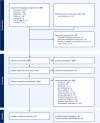The Effects of Dexmedetomidine on Postoperative Delirium in Adult Cardiac Surgical Patients: A Bayesian Meta-Analysis and Trial Sequential Analysis
- PMID: 40490856
- PMCID: PMC12149363
- DOI: 10.1111/aas.70069
The Effects of Dexmedetomidine on Postoperative Delirium in Adult Cardiac Surgical Patients: A Bayesian Meta-Analysis and Trial Sequential Analysis
Abstract
Background: An acute episode of delirium among adults following cardiac surgery is associated with increased length of stay in intensive care, prolonged mechanical ventilation, and increased risk of mortality. This robust systematic review with Bayesian meta-analysis, including trial sequential analysis, has been undertaken to explore the use of dexmedetomidine to reduce the occurrence of delirium.
Methods: A systematic search for relevant published clinical trial reports was registered on PROSPERO (CRD42023460126) and guided by the PRISMA statement guidelines. Databases included Cochrane, CINAHL, PubMed, Embase, Medline and PsychInfo. Studies included were randomised controlled trials reporting on the adult population (> 18 years) undergoing cardiac surgery, comparing dexmedetomidine to another drug or placebo. Trials of paediatric populations, protocols and reviews were excluded. The primary outcome examined was the effect of dexmedetomidine on the incidence of delirium in postoperative cardiac surgery in the Intensive Care Unit (ICU). Secondary outcomes of interest were the occurrence of hypotension, bradycardia, length of ICU stay and sedation utilised in the control and comparator groups. Trial sequential analysis and meta-regression were used to explore heterogeneity. Risk ratios (RRs) and Bayesian posterior probabilities are presented. The prior for this was empirical, being based on distributions for emergency and critical care systematic reviews from the Cochrane Database. The Cochrane ROB-2 tool was utilised to assess risk of bias, and the GRADE approach for certainty of evidence is presented.
Results: A total of 699 randomised control trials were identified. After the removal of duplicates and screening for eligibility, 27 studies were included in the meta-analysis. The Robust Bayesian Model Averaging summary effect for delirium prevention was estimated to be 0.76 (95% credible interval [CrI] 0.56-1.00) for using dexmedetomidine, with a posterior probability of 97% of any treatment effect. Meta-regression suggested that the baseline risk of delirium is a strong indicator of increased effectiveness, and trial sequential analysis indicates potential effectiveness. A low risk of bias was evident in 19 of the 27 studies, 6 studies had some risk of bias, and 2 studies were judged to be high risk. The certainty of evidence used across the 27 studies was determined to be low overall.
Conclusions: Dexmedetomidine may reduce the risk of delirium among adults following cardiac surgery; however, uncertainty remains due to heterogeneity. Therefore, adequately powered and well-designed multi-centre trials are needed to address this current uncertainty.
Editorial comment: The effects of dexmedetomidine on postoperative delirium in adult cardiac surgical patients: a Bayesian meta-analysis and trial sequential analysis. This systematic review with meta-analysis concerning evidence for possible effects of dexmedetomidine on post-cardiac surgery delirium presents detailed analysis showing a possible treatment drug effect on reducing post-operative delirium in this type of cohort, though still with some uncertainty.
Keywords: cardiac surgery; confusion; delirium; dexmedetomidine; intensive care; postoperative.
© 2025 The Author(s). Acta Anaesthesiologica Scandinavica published by John Wiley & Sons Ltd on behalf of Acta Anaesthesiologica Scandinavica Foundation.
Conflict of interest statement
The authors declare no conflicts of interest.
Figures










References
-
- Government A , Delirium Clinical Care Standard (Australian Institute of Health and Welfare, 2015).
-
- Ely E. W., Inouye S. K., Bernard G. R., et al., “Delirium in Mechanically Ventilated Patients: Validity and Reliability of the Confusion Assessment Method for the Intensive Care Unit (CAM‐ICU),” JAMA 286 (2001): 2703–2710. - PubMed
-
- McCusker J., Cole M., Dendukuri N., and Belzile E., “Does Delirium Increase Hospital Stay?,” Journal of the American Geriatrics Society 51 (2003): 1539–1546. - PubMed
Publication types
MeSH terms
Substances
LinkOut - more resources
Full Text Sources
Medical

